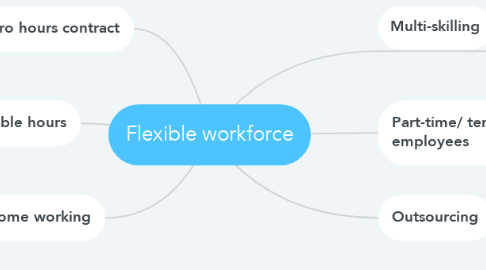
1. Zero hours contract
1.1. Advantages
1.1.1. Employers don’t not have to provide employees with any particular working hours
1.1.2. Employees not obliged to accept hours
1.2. Disadvantages
1.2.1. Leaves employee without security of a reliable income
2. Flexible hours
2.1. Advantages
2.1.1. Employees
2.1.1.1. Set number of hours per week, income per month is set
2.1.1.2. Can choose hours and can take a day off that best suits them
2.1.2. Employers
2.1.2.1. Can budget for employees wages and calculate the end of the budget for extra hours
2.2. Disadvantages
2.2.1. Employees
2.2.1.1. No granteed days or hours
2.2.2. Employers
3. Home working
3.1. Advantages
3.1.1. Employees
3.1.1.1. Reduces time and cost of commuting
3.1.1.2. Working hours may be more flexible and suit lifestyle requirements
3.1.2. Employers
3.1.2.1. Less office since and other overheads means lower costs
3.1.2.2. Productivity can increase when away from workplace distractions
3.2. Disadvantages
3.2.1. Employees
3.2.1.1. Can be lonely without the company of fellow workers
3.2.1.2. The home needs to be equipped as a work space
3.2.2. Employers
3.2.2.1. Employers must trust that the employee will work efficiently without supervision
4. Multi-skilling
4.1. Benefits: staff absences can be easily covered without any loss of production.
4.2. The business can respond to unexpected changes in demand and special orders.
4.3. The business becomes much more flexible
4.4. Employees may find that their jobs are less tedious or repetitive and respond to increased responsibility
5. Part-time/ temporary employees
5.1. Employee advantages
5.1.1. Suits workers such as parents and students
5.1.2. Flexible hours are more appealable to some employees
5.1.3. More affordable op
5.2. Employee disadvantages
5.2.1. Lack of job security and full employee rights
5.3. Employer advantages
5.3.1. Pay staff when needed reducing labour costs
5.3.2. Less costly in terms of employment rights
5.3.3. More flexible and affordable option
5.3.4. Increased number of applicants
5.3.5. This is the practice of training employees so that they have the ability to do a range of tasks, or of recruiting employees who have several skills.
5.3.6. Can retain full time workers by offering full time work
5.3.7. Meets business short term needs
5.4. Employer disadvantages
5.4.1. Employees may not be as committed or motivated
6. Outsourcing
6.1. Advantages
6.1.1. Business can get specialised knowledge of the other company as it will be more cost effective and/or they may be more experienced
6.1.2. Labour costs are reduced as buiness only sources help when it is required, it is not a set salary for the year
6.1.3. Enables the business to concentrate on its specialised area and leaves somebody with special Ed knowledge to focus on the set task.
6.2. Disadvantages
6.2.1. Business may not have full control over the quality of the outsourced work and it requires very good communication
